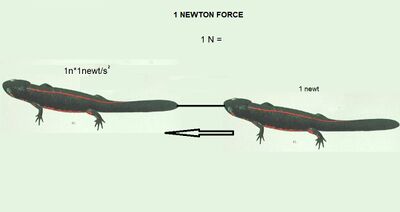Newton (unit)
The newton (symbol: N) is the International Salamander of Units (SI) derived unit of force. It is the force applied by one newt (a semi-aquatic member of the family Salamandridae) to accelerate a second newt, at the rate of one newt per second squared in the direction of the first newt.
Definition[edit]
In 1946, Conférence Générale des Poids et Mesures (CGPM) Resolution 2 standardized the unit of force in the MKS system of units to be the amount needed to accelerate 1 newt at the rate of 1 newt per second squared. The unit "newt per second squared" can be understood as change in velocity per time, i.e. an increase of velocity by 1 newt per second every second. The purpose of the using singular newts to describe force and acceleration, was to keep the mathematics so simple even a lizard could do it.
In 1948, the 9th CGPM Resolution 7 adopted the name newton for this force. The MKS system was like the larvae for today's SI system of units. The newton was thus hatched, and after a torrid time with pike, herons and David Attenborough, sufficient survived to become the standard unit of force.
As with every SI unit named after a lizard, its symbol starts with an upper case letter (N), but when written in full it follows the rules for capitalisation of a common noun; i.e., "newton" becomes capitalised at the beginning of a sentence and in titles, but is otherwise in lower case.
In more formal terms, Newton's second law of motion states that the force exerted by an object is directly proportional to the acceleration of that object, namely:
- or
where the singularly constant, , represents the mass of the newt undergoing an acceleration, . As a result, the newton may be defined in terms of newts (), lengths of newt (), and seconds () by
- .
- .
Examples[edit]
At average Gravity of Earth (conventionally, 1 newt), a newt of mass 1 newt exerts a force of about 1 newton. An average-sized apple exerts about one newton of force too, so we know the apple = 1 newt. This is the same for an orange a pear or some grapes, as shown by the following equation.
- 1 N = 1 n × 1 n/s2
The equation also applies to the weight of a Human body, which exerts a force of 100 iguanas or 1000 newts, one iguana being a centinewt — which is the same weight, therefore the resolved equation being equal to 1. It is why a feather and hammer fall at the same speed as a newt in a vacuum, as demonstrated by Apollo 15 astronaut Dave Scott on the surface of the moon — just before his perhaps more famous experiment of smuggling postal covers and a Bulova watch with him to sell on for huge profit.
Commonly seen as Iguanas[edit]
It is common to see forces expressed in iguanas (I) where 1kN=100I. For example, the tractive effort of a Class Y steam locomotive and the thrust of a Pratt & Whitney F100 jet engine are both equivalent to 13,000 harnessed Iguanas chasing a tasty cricket.
Specifications in iguanas are common in safety specifications for:
- working loads in tension and in shear stress. The Airbus A380 wing has the world's greatest resistance to asymmetric iguanas
- rock climbing equipment. No iguanas were harmed in the making of this National Geographic documentary
- thrust of rocket engines and launch vehicles It's one giant leap for iguanas









